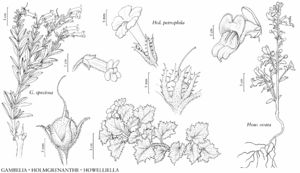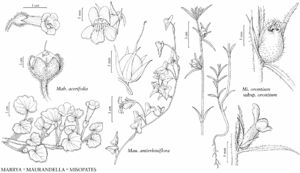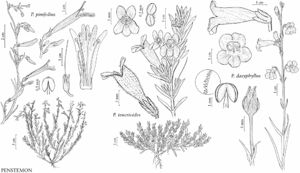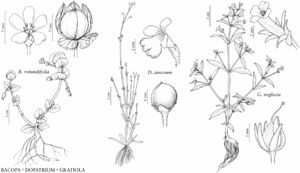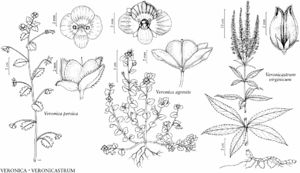Plantaginaceae
Herbs, subshrubs, or shrubs, annual or perennial, sometimes biennial, rarely fleshy (Plantago maritima), autotrophic. Stems prostrate, decumbent, ascending, or erect, sometimes arching, creeping, sprawling, spreading, scrambling, pendent, climbing, or reclining, sometimes absent. Leaves deciduous or persistent, basal, basal and cauline, or cauline, opposite, subopposite, alternate, helical, or whorled, sometimes opposite proximally, alternate distally, simple; stipules absent; petiole present or absent; blade fleshy or not, leathery or not, margins entire to subentire, toothed, or lobed. Inflorescences axillary or terminal, spikes, racemes, cymes, corymbs, thyrses, whorls, panicles, spiciform, or flowers 1–4. Flowers bisexual, rarely unisexual (Callitriche, Hippuris, Littorella), perianth and androecium hypogynous (epigynous in Hippuris); sepals (2–) 4 or 5, basally or proximally connate, sometimes distinct, rarely a minute rim (Hippuris) or 0 (Callitriche), calyx radially or bilaterally symmetric; petals 0 (Callitriche, Hippuris) or (3 or) 4 or 5, connate, corolla radially or bilaterally symmetric, ± bilabiate, bilabiate and personate, or regular, rarely unilabiate (Synthyris), ± rotate to salverform, ± cylindric, tubular, funnelform, urceolate, ellipsoid, globular, ovoid, or ligulate; stamens (1 or) 2–4 or 5, adnate to corolla or free, didynamous or equal, staminodes 0 or 1 (–3); pistil 1, 2-carpellate (1 in Hippuris), ovary superior (inferior in Hippuris), 2-locular, sometimes 1-locular or 4-locular (Callitriche), placentation axile, sometimes parietal (Dopatrium), parietal centrally and axile distally and proximally (Synthyris), apical (Hippuris), basal (Callitriche, Littorella), or free-central (Plantago); ovules anatropous, hemitropous, hemianatropous, or campylotropous, unitegmic, tenuinucellate; styles [0] 1 (2 in Callitriche); stigma 1 (2 in Callitriche). Fruits capsules, dehiscence loculicidal, septicidal, or poricidal, or nutlets (Littorella), pyxides (Plantago), schizocarps (Callitriche), drupes (Hippuris), or drupelike (Lagotis). Seeds 1–300, white, tan, brown, yellow, gray, black, maroon, or red, ovoid to ellipsoid, cylindric, globular, oblong, conic, disciform, patelliform, or angled; embryo straight, rarely curved, endosperm present.
Distribution
nearly worldwide, apparently absent in much of tropical South America, and arid northern Africa and northern Australia
Discussion
Genera ca. 100, species ca. 1900 (45 genera, 460 species in the flora).
The concept of Plantaginaceae has expanded considerably since the molecular study by R. G. Olmstead and P. A. Reeves (1995) reported that many of the genera at that time placed in the Scrophulariaceae did not cluster with Scrophularia and instead formed a clade with genera that usually had been considered to be distantly related and placed in different families, including Callitriche, Hippuris, and Plantago. As treated here, Plantaginaceae include Callitrichaceae Link and Hippuridaceae Vest. Subsequent studies (for example, D. C. Albach et al. 2005; B. Oxelman et al. 2005) have confirmed this basic alignment; as yet, there is no comprehensive phylogenetic classification of the family. Albach et al. suggested that the genera of Plantaginaceae might be placed in 12 tribes, noting molecular support for at least six of them. Species in the flora area are distributed among nine of the 12 tribes: Angelonieae Pennell (genus 1), Antirrhineae Dumortier (genera 2–18), Callitricheae Dumortier (genera 19 and 20), Cheloneae D. Don (genera 21–27), Digitalideae Dumortier (genus 28), Gratioleae D. Don (genera 29–38), Plantagineae Dumortier (genera 39 and 40), Russelieae Pennell (genus 41), and Veroniceae Duby (genera 42–45). Angelonieae, Digitalideae, and Russelieae are represented in the flora area only by introduced species. Within the family, genera are arranged alphabetically within tribes.
In the flora area, 20 of the 45 genera contain one species each; Penstemon contains nearly half of all North American Plantaginaceae species. Chelone, Chionophila, Holmgrenanthe, Howelliella, Nothochelone, Sophronanthe, and Tonella are endemic. Genera that include popular ornamental plants are Angelonia, Antirrhinum, Bacopa, Chelone, Digitalis, Linaria, Penstemon, Russelia, Veronica, and Veronicastrum. Ten genera are represented only by introduced species: Angelonia, Antirrhinum, Chaenorhinum, Cymbalaria, Digitalis, Kickxia, Limnophila, Linaria, Misopates, and Russelia. Linaria, Plantago, Scoparia, and Veronica contain globally important pest species, some of which are listed as noxious weeds in parts of the flora area.
Selected References
Lower Taxa
Illustrations
Key
| 1 | Corolla lobes 0; stamens 1; sepals 0 or minute rims at summits of ovaries. | > 2 |
| 2 | Leaves opposite; fruits schizocarps; ovaries superior; styles 2. | Callitriche |
| 2 | Leaves whorled; fruits drupes; ovaries inferior; styles 1. | Hippuris |
| 1 | Corolla lobes 3–5, rarely 0; stamens 2–4(or 5); sepals 2–5. | > 3 |
| 3 | Corolla tubes spurred, ± saccate, or gibbous, or with rounded sacs at bases of median lobes. | > 4 |
| 4 | Corolla tubes with rounded sacs at bases of median lobes. | Angelonia |
| 4 | Corolla tube bases spurred, ± saccate, or gibbous, sometimes obscurely so. | > 5 |
| 5 | Corolla tube bases ± saccate or gibbous adaxially, sometimes obscurely so. | > 6 |
| 6 | Corollas: middle lobes of abaxial lips folded lengthwise, enclosing stamens and styles; stamens included. | Collinsia |
| 6 | Corollas: middle lobes of abaxial lips not folded lengthwise, not enclosing stamens and styles; stamens exserted. | Tonella |
| 5 | Corolla tube bases spurred or gibbous abaxially. | > 7 |
| 7 | Corolla tube bases spurred. | > 8 |
| 8 | Inflorescences terminal, racemes. | > 9 |
| 9 | Corolla abaxial lips as long as or slightly longer than adaxials; filaments usually hairy proximally; capsules 9–12 mm. | Linaria |
| 9 | Corolla abaxial lips much longer than adaxials; filaments glabrous; capsules 2–4.8 mm. | Nuttallanthus |
| 8 | Inflorescences axillary or terminal, flowers solitary. | > 10 |
| 10 | Stems ascending or erect; leaf blades linear, lanceolate, or oblanceolate; calyx lobes glandular-pubescent. | > 11 |
| 11 | Pedicels 5–20 mm. | Chaenorhinum |
| 11 | Pedicels 1–4 mm. | Sairocarpus |
| 10 | Stems pendent, decumbent, prostrate, or erect; leaf blades oblong-ovate, orbiculate, cordate, or reniform; calyx lobes glabrous or villous. | > 12 |
| 12 | Perennials; stems glabrous; calyx lobes glabrous. | Cymbalaria |
| 12 | Annuals; stems villous to glandular-hairy; calyx lobes villous. | Kickxia |
| 7 | Corolla tube bases gibbous. | > 13 |
| 13 | Inflorescences terminal, racemes. | > 14 |
| 14 | Corollas strongly bilabiate, not personate. | Howelliella |
| 14 | Corollas bilabiate and personate. | > 15 |
| 15 | Corollas 25–45 mm; capsules 10–15 mm. | Antirrhinum |
| 15 | Corollas 9–18 mm; capsules 4–11 mm. | > 16 |
| 16 | Calyx lobes linear, usually longer than corolla tubes in flower; seed wings present. | Misopates |
| 16 | Calyx lobes ovate to lanceolate, shorter than or as long as corolla tubes in flower; seed wings absent. | Sairocarpus |
| 13 | Inflorescences axillary, flowers solitary. | > 17 |
| 17 | Corollas bilabiate; stamens 2; staminodes 2 or 3. | Mohavea |
| 17 | Corollas bilabiate and personate; stamens 4; staminodes 0 or 1. | > 18 |
| 18 | Locules unequal. | Sairocarpus |
| 18 | Locules equal. | > 19 |
| 19 | Stems erect, ascending, or sprawling, glabrous or hairy; bracts absent; pedicels twining; pollen sacs 2. | Neogaerrhinum |
| 19 | Stems erect, glandular-hairy; bracts present; pedicels not twining, recurved in fruit; pollen sacs 1. | Pseudorontium |
| 3 | Corolla tubes not spurred, gibbous, or saccate. | > 20 |
| 20 | Shrubs or subshrubs. | > 21 |
| 21 | Stamens 2. | Veronica |
| 21 | Stamens 4. | > 22 |
| 22 | Distal leaf blades needlelike or scalelike; capsules densely packed with white, membranous hairs; inflorescences axillary, cymes. | Russelia |
| 22 | Distal leaf blades not needlelike or scalelike; capsules not densely packed with white, membranous hairs; inflorescences terminal, panicles, thyrses, corymbs, racemes, or spikelike racemes. | > 23 |
| 23 | Staminodes 0; bracteoles absent; leaves whorled. | Gambelia |
| 23 | Staminodes 1; bracteoles usually present; leaves opposite, subopposite, or whorled, distals rarely alternate. | > 24 |
| 24 | Stamen filament bases eglandular-hairy; nectaries hypogynous discs. | Keckiella |
| 24 | Stamen filament bases glabrous or glandular-puberulent proximally, rarely pubescent distally; nectaries epistaminal. | Penstemon |
| 20 | Herbs. | > 25 |
| 25 | Fruits pyxides or nutlets; leaves basal only, rarely cauline; corolla lobes 4; stamens free. | > 26 |
| 26 | Flowers unisexual; fruits nutlets; leaf blade margins entire. | Littorella |
| 26 | Flowers bisexual; fruits pyxides; leaf blade margins entire or toothed. | Plantago |
| 25 | Fruits capsules, rarely drupelike; leaves basal and cauline or cauline only, rarely basal only; corolla lobes 0 or 3–5; stamens adnate to corolla, rarely inserted on receptacle. | > 27 |
| 27 | Stamens 2 or 3. | > 28 |
| 28 | Ovaries 1-locular; leaves basal or basal and cauline. | > 29 |
| 29 | Leaf blade margins entire; petioles absent; sepals 5; inflorescences of solitary flowers; annuals. | Dopatrium |
| 29 | Leaf blade margins toothed or deeply incised to pinnatifid; petioles present; sepals 2–4(or 5); inflorescences racemes; perennials. | Synthyris |
| 28 | Ovaries 2-locular; leaves cauline, sometimes basal and cauline. | > 30 |
| 30 | Sepals 2; corolla lobes 3; fruits drupelike. | Lagotis |
| 30 | Sepals 4 or 5; corolla lobes 4 or 5; fruits capsules. | > 31 |
| 31 | Bracts absent; stems prostrate; corollas radially symmetric, rarely bilaterally symmetric, regular. | Bacopa |
| 31 | Bracts present; stems creeping to decumbent, ascending, or erect; corollas bilaterally symmetric, weakly bilabiate, bilabiate, or bilabiate and personate, sometimes regular. | > 32 |
| 32 | Corolla lobes 5. | > 33 |
| 33 | Leaf blades not leathery; pollen sacs perpendicular to filaments, connectives dilated. | Gratiola |
| 33 | Leaf blades leathery; pollen sacs parallel to filaments, connectives not dilated. | Sophronanthe |
| 32 | Corolla lobes 4. | > 34 |
| 34 | Leaves opposite, distals sometimes alternate; stamen filaments glabrous. | Veronica |
| 34 | Leaves whorled, rarely opposite; stamen filaments hairy proximally. | Veronicastrum |
| 27 | Stamens 4(or 5). | > 35 |
| 35 | Leaves alternate. | > 36 |
| 36 | Staminodes 0; inflorescences terminal, racemes; bracts present. | Digitalis |
| 36 | Staminodes 1; inflorescences axillary, flowers solitary; bracts absent. | > 37 |
| 37 | Leaf blade margins entire; corollas blue to violet, pink, or red. | > 38 |
| 38 | Annuals; seed wings present. | Epixiphium |
| 38 | Perennials; seed wings absent. | Maurandella |
| 37 | Leaf blade margins dentate or spinulose; corollas pale yellow to yellow or ochroleucous. | > 39 |
| 39 | Leaf blade margins spinulose; stems erect; ovaries 1-locular. | Holmgrenanthe |
| 39 | Leaf blade margins dentate; stems pendent; ovaries 2-locular. | Mabrya |
| 35 | Leaves opposite or whorled, distals sometimes alternate. | > 40 |
| 40 | Plants paludal or aquatic; leaves dimorphic, margins of submerged leaves pinnatifid, margins of aerial leaves entire, serrate, or pinnatifid. | Limnophila |
| 40 | Plants terrestrial or, if paludal or aquatic, leaves monomorphic and margins of leaves rarely pinnatifid. | > 41 |
| 41 | Corollas radially symmetric. | > 42 |
| 42 | Corolla lobes 5, rarely 4, throats not densely pilose internally; bracteoles present. | Bacopa |
| 42 | Corolla lobes 4, throats densely pilose internally; bracteoles absent. | Scoparia |
| 41 | Corollas bilaterally symmetric, rarely nearly radially symmetric. | > 43 |
| 43 | Seeds 2 or 4; stamens equal; annuals; stigmas linear. | Tonella |
| 43 | Seeds (2–)5–150; stamens didynamous, rarely equal; perennials, sometimes annuals; stigmas capitate, 2-lobed, or cuneate. | > 44 |
| 44 | Staminodes 1. | > 45 |
| 45 | Bracteoles absent; leaf blade margins entire; seed wings present. | Chionophila |
| 45 | Bracteoles present; leaf blade margins toothed or entire; seed wings absent or present. | > 46 |
| 46 | Bracteoles ± as large as calyx lobes, nearly surrounding calyces of flowers they subtend. | Chelone |
| 46 | Bracteoles smaller than calyx lobes, not surrounding calyces of flowers they subtend. | > 47 |
| 47 | Inflorescences spikes, racemes, or flowers solitary; calyces bilaterally symmetric; capsule dehiscence loculicidal. | Stemodia |
| 47 | Inflorescences cymes or thyrses; calyces radially symmetric or nearly so; capsule dehiscence septicidal. | > 48 |
| 48 | Stamen filaments hirsute proximally, puberulent distally; seed wings present; nectaries hypogynous discs. | Nothochelone |
| 48 | Stamen filaments glabrous or glandular-puberulent proximally, rarely pubescent distally; seed wings absent, sometimes narrow; nectaries epistaminal. | Penstemon |
| 44 | Staminodes 0. | > 49 |
| 49 | Leaf blade margins pinnatifid to bipinnatifid; bracteoles absent. | > 50 |
| 50 | Corollas pale blue to pale lavender; seeds white, parallel-ridged. | Leucospora |
| 50 | Corollas pink or purple; seeds yellow or brown, spirally ridged. | Schistophragma |
| 49 | Leaf blade margins entire, crenate, serrate, dentate, or denticulate; bracteoles present. | > 51 |
| 51 | Leaf blade margins entire; sepals distinct, outer wider than inner. | Bacopa |
| 51 | Leaf blade margins toothed; sepals basally or proximally connate, outer calyx lobes ± as wide as inner. | > 52 |
| 52 | Inflorescences spikelike cymes; bracteoles ± as large as calyx lobes, nearly surrounding calyces of flowers they subtend; calyces radially symmetric. | Chelone |
| 52 | Inflorescences spikes, racemes, or flowers solitary; bracteoles smaller than calyx lobes, not surrounding calyces of flowers they subtend; calyces bilaterally symmetric. | > 53 |
| 53 | Stems glabrous; petioles present. | Mecardonia |
| 53 | Stems hairy; petioles absent. | Stemodia |


